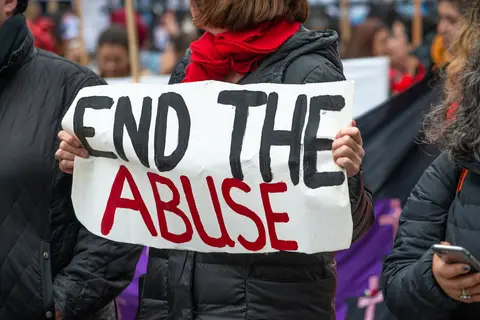Content warning: This story discusses domestic abuse and contains content that may be disturbing to some.
Resources: The National Domestic Violence Hotline can be reached at 1-800-799-SAFE (7233).
A new report for the Council on Criminal Justice has found that, during lockdowns, domestic violence rose by an average of about 8%, both worldwide and in the United States.
That’s based on data from those who were able to seek help, and it may represent just a fraction of the abuse that victims have been suffering in the pandemic. While social isolation, unemployment and high stress describe pandemic life, they’re also the conditions that can lead to the most severe violence. Many victims have been trapped at home with their abusers.
“Access to a victim increases domestic violence, whether it’s intimidation, harassment, physical violence, sexual violence [or] verbal abuse,” said Ruth Glenn, president of the National Coalition Against Domestic Violence.
Glenn said calling for help when an abuser is nearby is dangerous, which is likely why many police departments have received fewer 911 calls about domestic incidents during the pandemic.

Meanwhile, in many places there’s also been a spike in domestic aggravated assaults. Those include the most extreme forms of violence: strangulations, stabbings and shootings.
According to Diane Lance, a national expert on family violence who heads the Office of Family Safety in the Nashville, Tennessee, metro area, one reason the “proportion of abuse is so much more severe” is that victims are waiting longer to get to a shelter or a family safety center, like the one she runs.
In the pandemic, Lance said, she has seen more clients come when the situation is so bad they finally tell themselves, “I’ve got to make it there. I might be killed.”
That was the experience of one Memphis, Tennessee, woman in lockdown with her abuser.
“The more we were not able to do anything, the worse he got,” said the woman, whose name is being withheld for her safety.
Her now ex-husband became violent gradually over their four-year relationship, she said. He often threatened to kill her if she left him, she said, and hit her where her injuries wouldn’t show.
But last summer, she said, he lost all control: “The last time he got really physically violent with me, he threw me up against the wall, and he kicked me really hard in my stomach where I was throwing up blood.”
If she hadn’t escaped and made it to a shelter, she said, she believes she’d be dead. In fact, in Memphis domestic homicides nearly doubled last year over 2019.
That’s the kind of data that went into the report for the Council on Criminal Justice. Lead author Alex Piquero, who is sociology chair at the University of Miami, said he and four other researchers studied hundreds of records, including arrests, 911 calls and hospitalizations. But there’s so much more abuse that isn’t quantifiable, he noted.
“Remember, this is physical violence,” said Piquero. “I’m convinced the emotional violence is even higher because there’s never an arrest for emotional violence.”
Which is why, he said, the pandemic’s full effect on victims may never be known.
Reporting for this story was supported by a grant from the Pulitzer Center for the project Surging in Silence, produced in partnership with the Institute for Public Service Reporting at the University of Memphis, Nashville Public Radio and the Nashville Scene.










